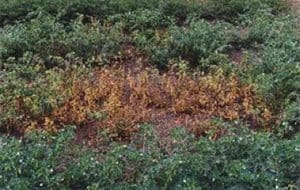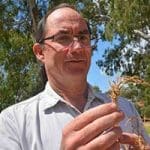THE addiction of Ascochyta blight to the list of diseases detected by the DNA-based soil test, PredictaB, will give chickpea growers an extra tool to assess inoculum carryover from previous chickpea crops and help them make more informed decisions on paddock selection

Pre-plant testing for Ascochyta inoculum levels will help farmers counter the disease which can devastate chickpea crops.
The test for assessing Ascochyta inoculum levels will be particularly important for northern growers who, lured by attractive prices, have grown big areas of chickpeas in recent years but have had their crops hit hard by the disease, particularly when they are grown back-to-back.
Crown Analytical Services director, Rob Long, who with colleague Drew Penberthy is the service provider for PredictaB in the northern region, said introducing a test for Ascochyta provided additional information for growers, particularly when it came to chickpea paddock selection, prioritising early fungicide applications and long term rotation planning.
“If you have a handle on the amount of inoculum in a paddock there is a direct link with how that will flow through and have an impact on next year’s potential disease,” he said.
“For this coming season the interesting thing will be to go into paddocks that grew chickpeas in 2016 with heavy disease pressure that presumably are wheat at the moment in 2017, but there may be intention for them to go back to chickpeas.
“Chickpeas are still reasonably priced and there may be an inclination for growers to go back to chickpeas in that rotation, so PredictaB could be a seriously good option for them to work out exactly what sort of disease risk they are going to run.”
Mr Long said the time to do the test was at pre-plant in autumn so there had been ample opportunity for all the mitigating factors, such as weather, to dissipate what risk might be there.
“We think March or April will be good timing so growers have ample opportunity to change things around if they have to, but late enough to give a reliable indication of what the actual risk rating is,” he said.
“It might mean that people can, with confidence, grow chickpeas in a tighter rotation or it might also mean they have to stick to their knitting and keep it four years apart between chickpea crops.
“The thing will be, coming into next year, if there is a high demand for growers to grow chickpeas again and we are going onto paddocks that were known to be heavily infested with Ascochyta in 2016, without knowing the data or information most advisers would say it would be too close.”
The research and development work for PredictaB has been carried out by the South Australian Research and Development Institute (SARDI).
SARDI research leader, soil biology and diagnostics, Alan McKay, said while there was now a high level of confidence in the test’s capacity to detect Aschochta inoculum in a paddock, the challenge was to determine what those levels meant in terms of risk to a following crop.
“We are getting better at developing tests faster and validating them. The bottleneck these days is working out the disease risk categories from the tests,” he said.
Dr McKay said the GRDC had given approval for any report into the results of PredictaB tests for Ascochyta to include a separate box called: “test under development”.
“We can give a level we have detected and we can give a category for the results based on population density where we use a range of samples across the industry to work out the range of levels that have been detected,” he said.
“We can say to a grower: “Your sample sits within this range compared to the industry”. It is not saying it is a high or low disease risk, because we don’t know the relationship to disease, but we can group them by population density. It is a way for growers to start looking at using the test to monitor levels in paddocks.”
Dr McKay said while it wasn’t possible yet to be definitive about the level of risk the detection of the disease had, if the it was picked up in a sample it at least warned growers to be extra careful.
“It is just another way of confirming you are taking a risk and you need to put in place a strategy to manage that risk,” he said.
“As we get more information on the levels and consultants start to see patterns, they might be able to say that if it is a low level, this is an appropriate management strategy – if it’s a high level, we really shouldn’t take the risk with chickpeas.
“But at the moment we can’t draw the line between what is an acceptable risk and what is an unacceptable risk. We can’t develop risk categories from the laboratory. It needs field data to do it.”
PredictaB technology was initially introduced as a diagnostic tool for detecting root lesion nematodes, but has since been developed to cover a range of other pests and pathogens, including crown rot, head scab fungus, cereal cyst nematode, phytophthera root rot, pythium root rot and rhizoctonia.
…………….
2017 Root Disease Risk Management Courses for accrediting consultants:
Workshop locations:
Monday 6 November: Adelaide, SA, Waite Campus, SARDI Plant Research Centre
Thursday 9 November: Bendigo, Vic, The Capital, Bendigo Bank Theatre
Monday 20 November: Wagga Wagga, NSW, CSU Convention Centre
Wednesday 22 November: Dubbo, NSW, Dubbo RSL
Friday 24 November: Goondiwindi, Qld, Goondiwindi Community Cultural Centre
Friday 1 December: Perth, WA, Technology Park, Bentley



HAVE YOUR SAY